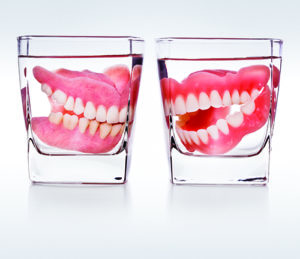
Regular dental checkups and hygiene can help prevent or catch age-related problems of the mouth, including cavities, gum disease, stomatitis and oral cancer.
By Ryan McBride
Open wide and say “Ahh”
It used to be thought that tooth decay and an overall decline in dental health were inevitable consequences of getting older. Not so, today. Thanks to advances in dental science and oral medicine—not to mention increasing longevity—we’re hanging on to our pearly whites for longer than ever.
But living longer does bring with it an increasing risk of needing complex dental treatments at some point, and developing oral and dental diseases that can have wide-reaching impacts on our overall health. Arthritis and other health conditions, along with the medications that treat them, can make it difficult to perform the daily chore of brushing and flossing. Even a few bad teeth can have a dramatic impact on our physical and social well-being, by making it hard to eat, speak, even smile. Poor oral health can also worsen maladies such as diabetes, or cause inflammation throughout your body.
So open wide, say “Ahh,” and let’s take a look at what you can do to ensure your teeth, gums and mouth remain as healthy as possible.
Mouth Problems, A-Z
With age comes an increasing risk of developing oral health problems such as:
Cavities. Sorry, these nasty buggers are not just for kids. According to Dental Hygiene Canada, seniors develop more cavities on the roots of their teeth than younger adults. Perhaps most worrisome, bacteria from cavities in the mouth can travel and develop into serious infections that affect your overall health.
Darkening teeth, due to changes in dentin, the bone-like tissues underneath your enamel, thinning enamel, and a lifetime consuming foods and beverages that stain.
Diminished sense of taste caused by aging, diseases, medications, and dentures.
Dry mouth (xerostomia), which can raise the risk of developing cavities and other oral problems. It’s often caused by reduced saliva flow thanks to certain cancer treatments, diseases and medications.
Gum disease caused by plaque buildup, and made worse by smoking, bridges and dentures that don’t fit properly, diseases such as diabetes and cancer, and poor diet.
Oral cancer, which is 7 times more likely if you’re over 65. Catch it early and you significantly improve your odds of controlling the disease.
Stomatitis, an inflammation of tissue beneath dentures caused by poor dental hygiene or a buildup of fungus.
Uneven jawbone caused by teeth shifting into the space left by a lost tooth that has not been replaced.
Prevention
You’ve heard it before. Whatever your age, regular professional dental care remains the foundation of good oral health. “You are never too old for healthy teeth and gums,” says the Canadian Dental Association website. That said, how you care for your teeth and gums may need to change as you age. Regular dental exams will give your dentist the opportunity to spot gum disease, cavities, loose fillings, broken teeth, infection, cancer and other problems as early as possible.
Another bit of good advice that never gets old: Just as an ounce of prevention is worth a pound of cure, “regular dental care and maintenance are always less expensive than treatment,” says the CDA.
That means—you guessed it—regular brushing and flossing.

How to brush your teeth
Brush at least twice a day to remove the plaque that causes gum disease and tooth decay.
- Choose a soft brush with rounded bristles that lets you reach your back teeth. Replace your toothbrush every three months.
- Brush in gentle circles at a 45 degree angle to your teeth. Don’t scrub or you’ll make your gums recede.
- Clean every surface of every tooth.
- Take your time: 2 to 3 minutes should ensure a thorough job.
- Brush your tongue.
If arthritis or some other health condition makes holding your toothbrush difficult, enlarge the handle with a sponge, several layers of foil, or a bicycle handle grip.
How to floss
Floss at least once a day to remove plaque and bacteria from places your toothbrush can’t reach. To make flossing a habit, keep your floss handy by the TV or radio.
- Take a length of floss as long as your arm. Wrap it around your middle fingers, leaving about two inches between your hands. Use your index fingers to guide the floss between your teeth.
- Slide the floss between your teeth and wrap it into a “C” shape around the base of the tooth and gently under the gum line. Wipe the tooth from base to tip two or three times.
- Floss both sides of every tooth. Don’t forget the backs of your last molars. Move to a new part of the floss as you move from tooth to tooth.
If your fingers get tangled or you have difficulty flossing, try using a plastic floss holder or dental tape instead.
Smile!
Here’s everything you wanted to know about dentures

What happens when you’re not able to keep your original teeth? A lost tooth should be replaced by an artificial one to prevent your other teeth from getting out of line. There are four types of artificial teeth, or dentures:
- A fixed bridge, held between healthy teeth on both sides. You cannot remove this by yourself.
- A partial bridge of one or more false teeth held in place by clasps, which you can remove yourself.
- Complete dentures replacing all your natural teeth.
- Dental implants attached by a small metal post to your jawbone.
Dentures and implants don’t let you off the hook when it comes to cleaning your teeth. Care for dentures as you would your natural teeth. While you should brush and floss a dental implant every day, you must be careful: it’s not as strong as a natural tooth. If you have dentures or implants, you’ll need to visit your dentist regularly to ensure they continue to fit properly as your mouth changes.
Oral Care Tips for Caregivers
In the event that you find yourself caring for the mouth of a family member or close friend, don’t be afraid to ask your dentist for advice. The Canadian Dental Association offers the following suggestions:
For natural teeth:
- Stand behind the person to brush and floss their teeth.
- Let the person sit in front of the sink. That way, you can make the same motions you use when you brush and floss your own teeth.
- Use a soft toothbrush. You may find an electric toothbrush easier to use when you brush someone else’s teeth. Ask the person if you are brushing too hard.
- Have the person rinse with warm water when you are done.
For complete or partial dentures:
- Let the person tell or show you how to take the complete dentures or “partial” out. (With complete dentures, put the upper set back first, and then the lower set.)
- Both kinds of dentures must be cleaned daily.
- Look for cracks in the denture. If you find any, take it to a dentist for repair.
- Fill the sink with water.
- Scrub the denture with a denture brush and soap.
- Rinse with water when you finish cleaning.
- Soak denture overnight. It can be soaked in a special cleaner for dentures (denture cleanser), in warm water or in a mix of warm water and vinegar (half and half). If the denture has metal clasps, use warm water only for soaking.
For mouth tissues:
- Ask if it is okay to look inside the person’s mouth.
- Check the mouth closely. Look for swelling, red or white patches, parts of the gums that have changed colour and sores that do not heal in a few days. If you see any of these things, call the person’s dentist.
- Clean and massage the inside of the person’s mouth with a damp cloth or a soft toothbrush.
Recent News

Winnipeg Jets Parkinson’s Disease Awareness Game!

Volunteer Profile: Carole Grier

